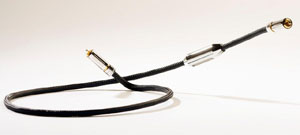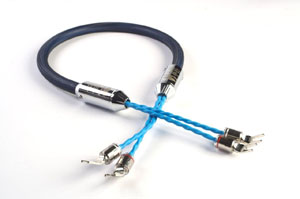Siltech, around for over 25 years and still delivering good old-fashion�craftsmanship
by Ernie Fisher
 It takes longer to evaluate a single cable, than it takes to review an entire system combination, and for this reason, I'm not fond of the task. However, a few cable manufacturers interest me as I regard them as innovators of the industry. Because of my interest in creative audio in general, I agreed to look at and evaluate the Classic cables by Siltech. It takes longer to evaluate a single cable, than it takes to review an entire system combination, and for this reason, I'm not fond of the task. However, a few cable manufacturers interest me as I regard them as innovators of the industry. Because of my interest in creative audio in general, I agreed to look at and evaluate the Classic cables by Siltech.
Long before the market became saturated with hundreds, if not thousands of cable peddlers, Siltech and a few other serious players began to make waves. They were the ones that took the cable industry to its present technology-driven designs, thereby pioneering the high-end of the cable industry. Siltech's head, Edwin van der Kley is such a player. He began his work with research way back in the early 1980s when most of the audio business disregarded the importance of connectors. Over the next few years Siltech developed and marketed a number of cables in various price ranges of which the Classic Anniversary series is the latest. It offers four models of both, interconnects and speaker cables. The Classic cables under review are the new 550 models, the second from the top design.
 Appearance Appearance
The cables I received for this review were sky-blue and easy on the eyes refreshing in a business where most designs sport black sleeves. It seems that other colours are also available. At one end of each cable a small barrel identifies maker and model. The RCAs are great and feature tightening sleeves. The speaker cable came with spades, although they are available with banana plugs (my preference).
The Sound
I have reviewed (and used) some of the best cables the industry's currently offers, and, though I hate to compare, sometimes it is necessary so as to establish a sonic disposition, a cable's voice.
In addition, all cables have sonic characteristics unique to their design. I've said it many times before, but I'd like to reiterate that the most desirable element in cable design is its degree of neutrality that allow users to clearly hear what the back-up equipment is all about. That, of course, is wishful thinking for the most part, but there are some very expensive cables that will allow a very good perspective into the world of reproduced sound. Nordost Valhalla, JPS Labs Aluminata, Crystal Cable's Dreamline and Ultra are contenders and only a handful of lower priced cables can compete. Enter, an old, yet new contender, the Silech Classic.
After many hours of listening to the Classic interconnects and speaker cables, I came to the conclusion that they have a high measure of sonic neutrality. The result was that I could clearly make out the sonic characteristics of the equipment used for the evaluation. Thus, I heard and recognized the sound of the Wyetech Labs amps and preamp, the energy and dynamics of the Bryston 14B SST, and indeed the personality of the Audio Aero Classic CD player. The Siltech exceeds similarly priced cables by recreating the recording space on the sound stage. Multi-dimensional imagery combines with focus on instruments and voices, consequently providing an intimate listening experience. Where the Classic's performance falls short of the highest-ranking conductors mentioned earlier is firmness in low midrange and upper bass regions. Notwithstanding, this small criticism doesn't hold water for those who like their sound as sweet-tempered and pleasant as one can imagine. I couldn't help but love the cables upper midrange and high frequency articulation, which never offended and always remained as smooth as a baby's. As music is but a succession of harmonics, it is most important for the cables to reconstruct them faithfully. The Classic cables do this very well indeed and I had no trouble identifying instruments. My evaluations always include listening to various pianos, such as Steinways, Yamahas, Baldwins and Boesendorfers; and if I can clearly hear the pianos voice, I know that the audio part is right on. The Classic cables passed this test easily, although I thought that the speaker cables did a better job than the interconnects. In spite of that, I can't fault the interconnects for lacking resolution throughout the audible frequency spectrum and, the most important element musicality. The all-round sound of the interconnects can be described as firm with an uninterrupted, smooth flow from top to bottom frequencies, somewhat sweetened highs and well refined, three-dimensional imaging capabilities.
The speaker cable's fundamental sonic personality is that of a great, almost achromatic conductor, which is desirable, of course. It allows unimpaired listening to the amplifier/speaker system, offers enough resolution to please audiophiles, ample musicality to delight the music lover and exhibits proper space/time harmony (space and time are joined together in an intimate combination in which time becomes the fourth dimension).
Synopsis & Commentary
In the mid seventies, when I was retailing, the price of an upscale cable was around two bucks a foot with top-of-the-line stuff selling for about five bucks a foot. Them were the old days. Now a multi-million dollar industry, cable manufacturers presently in the business should or must appreciate the efforts of its pioneers, the likes of Dr. van den Hal, Monstercable's Noel Lee, MIT's Bruce Brisson and, aye, Siltech's van der Kley. Those folks practically invented and developed the industry, initially marketing affordable conductors. However, it took quite some time before audiophiles embraced this development, but eventually the industry succeeded to prove that cables make a difference. As the merit of good cables became indisputable, almost all manufacturers began making cables in all price ranges, and many cables often exceeding the prices of amplifiers and loudspeakers. By the early 1990s, cables had become components, and I am of the opinion that any good audio system will benefit from the science of cable design.
The Classic cables are made by a very trustworthy company whose conscientious design and manufacturing operation continues to bring contemporary technology to consumers.
Siltech has been around for more than 25 years, pioneered many great cable designs and, guess what, they work their (musical) magic very well indeed. I consider the medium-priced Siltech Classic cables performance near high-end designs; the price is fair, the musicality is off the chart and all there is left to do is to find synergistic components to elicit the best performance. This old company has exciting new stuff and if good old craftsmanship is what you are looking for, try a Siltech.
|
